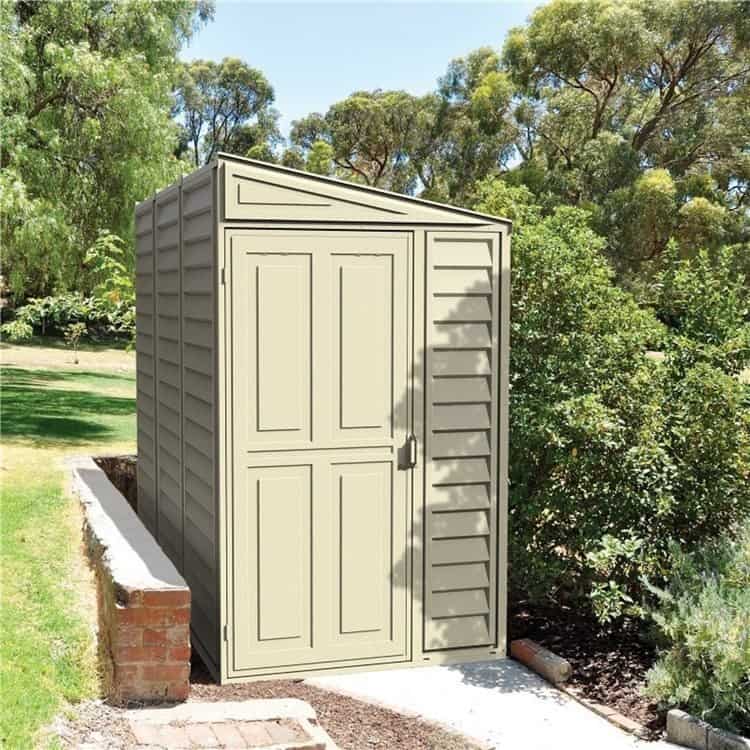Jump to:
Are you in need of some extra storage space? Installing a lean-to shed might be the perfect solution for you, providing the space you need. But where do you start?
In this step-by-step guide, we’ll walk you through the process of installing a lean-to shed. With a little bit of time, effort, and the right tools, you’ll have it situated in your outdoor space in no time!
Step 1: Planning and Preparation

When it comes to installing a lean-to shed, selecting the perfect location is crucial. Consider factors such as accessibility, sunlight exposure, and proximity to your main structure. You’ll want a spot that not only suits your needs but also blends seamlessly with your outdoor space.
Before you start construction, take accurate measurements of the chosen area. Determine the shed’s size, ensuring it fits comfortably without overwhelming the surroundings. Additionally, check local building codes and regulations to ensure compliance.
Depending on your location, you may need permission for the installation. Adhering to these guidelines will help ensure a smooth installation process. Taking these steps will set the foundation for a successful lean-to shed installation.
Step 2: Gathering Materials and Tools
To begin your lean-to shed installation, gather all the necessary materials. If you’re using a shed kit, ensure you have it readily available. If you prefer to build from scratch, here’s a list of common materials:
- pressure-treated lumber for framing
- plywood or OSB for the walls and roof
- roofing materials
- screws or nails
- hinges
- door handles
Additionally, consider insulation, moisture barrier, and paint or sealant for weatherproofing. For the installation process, you’ll typically need the following items:
- measuring tape
- level
- circular saw or mitre saw
- drill
- hammer
- screwdriver
- ladder
Depending on your project, you may need additional tools such as a jigsaw or framing nailer.
When sourcing materials and tools, local hardware stores are excellent options. They typically carry a wide range of shed materials and tools. Online retailers and specialised shed suppliers are also worth exploring.
Step 3: Foundation Preparation

When it comes to foundation, there are several options to consider. The most common options include:
- concrete slab
- treated wood skids
- concrete pier blocks
Before installing the foundation, prepare the ground properly. Start by clearing the area of any vegetation, rocks, or debris. Next, level the ground using a shovel and a level to ensure a solid and stable base. If necessary, add gravel or compact the soil to achieve a level surface.
Once the ground is prepared, proceed with the installation of your chosen foundation. If using a concrete slab, create formwork, pour and level the concrete, and allow it to cure. For treated wood skids, place them on the levelled ground — spaced and level. Concrete pier blocks, in contrast, can be positioned and levelled, with pressure-treated beams placed on top to support the shed.
Step 4: Assembling the Shed
Now that the foundation is in place, it’s time to assemble the lean-to shed. Here’s a breakdown of the assembly process into manageable steps:
- Begin by assembling the shed walls. Attach the wall panels to the base or floor frame according to your plans. If needed, follow the manufacturer’s instructions.
- Once the walls are in place, focus on the roof. Install the roof trusses or panels according to the provided instructions. Make sure they are securely fastened and properly aligned.
- Move on to installing the shed doors. Attach the door frame, hinges, and handles as instructed. Make sure the doors swing freely and latch securely.
Throughout the assembly process, ensure the structure is secure and stable. Here are some tips to achieve this:
- Double-check that all connections are tight and secure. Use appropriate screws or nails. Also, consider reinforcing critical joints with additional hardware if needed.
- Ensure the shed is level and plumb. Use a level and shims to adjust as necessary.
- Reinforce the shed’s corners and walls with bracing or corner brackets. This adds further stability.
- If desired, apply weather-resistant sealant or paint for extra weather protection.
Step 5: Attaching the Shed to the Existing Structure
Follow these steps for a secure attachment:
- Start by determining the connection points between the shed and the supporting structure. Locate studs or sturdy points on the existing building where the shed will be attached.
- Use a level to ensure the shed properly aligns with the existing structure. Make any necessary adjustments to achieve a level and flush connection.
- Attach the shed to the supporting structure using lag screws, brackets, or anchors. Pre-drill pilot holes to prevent wood splitting. Then, securely fasten the shed to the building using the chosen hardware.
- Reinforce the connection points with additional brackets or support beams if needed. This is especially important for larger or heavier sheds.
- Weatherproof the joint by sealing any gaps or seams with caulk or weatherstripping. This will prevent water infiltration.
Structural integrity is paramount. Ensure the connection is robust and able to withstand external forces such as wind or snow.
Step 6: Finishing touches
Once the lean-to shed is installed, there are some finishing touches you can consider. Painting the shed, for one, enhances its appearance and adds a layer of protection. Sealing the wood or applying a weatherproof coating also further extends its lifespan.
To make the most of the interior space, consider adding shelves or hooks to organise garden tools. Use vertical storage solutions to maximise storage capacity.
Maintaining and caring for your shed is essential for its longevity. Regularly inspect for any signs of damage, such as rot or pests. Keep the shed clean and free from debris. Treat the wood periodically to prevent deterioration. Proper upkeep will ensure it continues to serve its purpose for years to come!
Round-up
Congratulations on completing the installation of your lean-to shed! Throughout the assembly process, prioritise structural integrity and weatherproofing. Don’t forget to add your personal touch with optional finishes. Enjoy the benefits of your new lean-to shed and the convenience it brings to your outdoor space!










